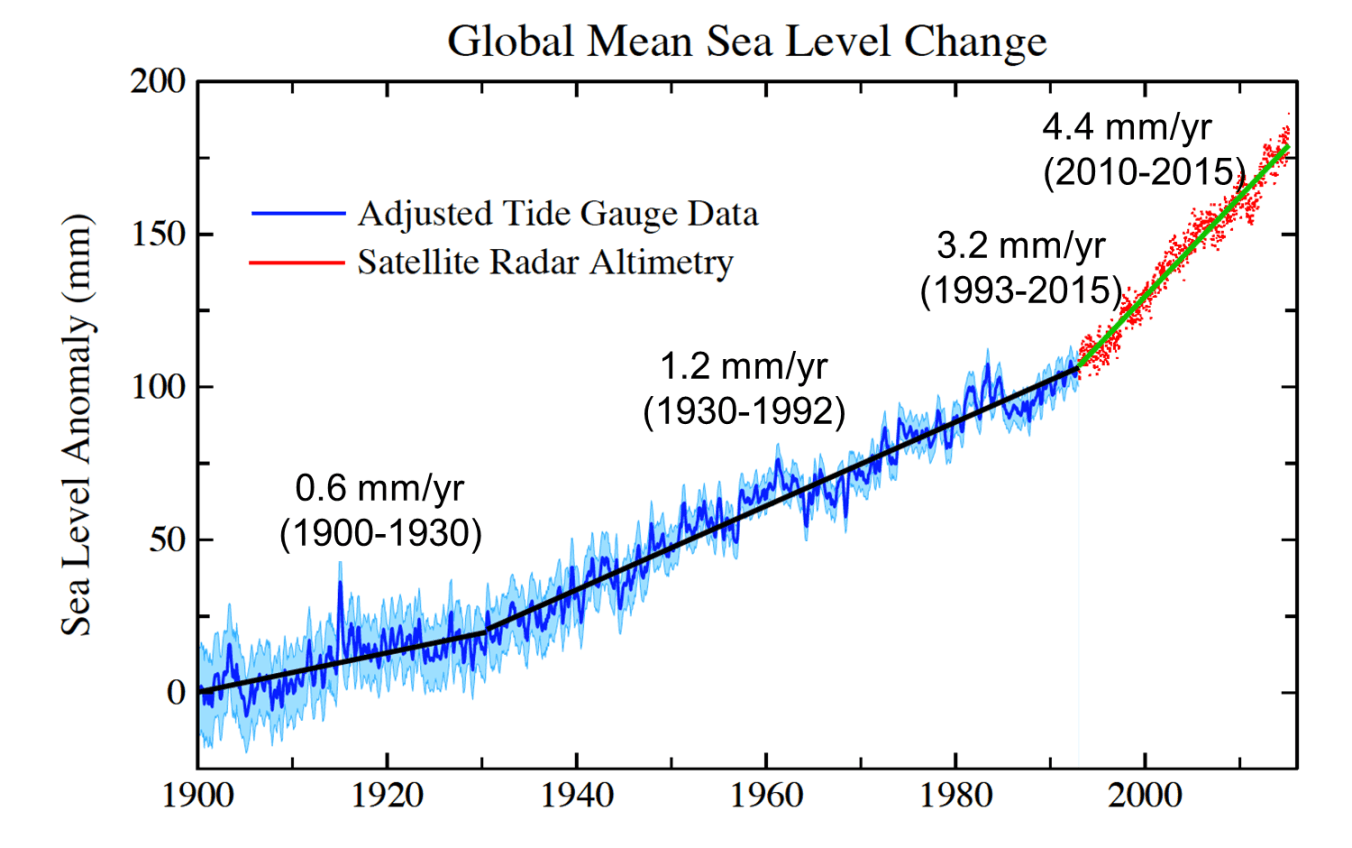Accelerating Sea Level Rise: Threat To Coastal Cities And Towns

Table of Contents
Causes of Accelerating Sea Level Rise
Several factors contribute to the alarming rate of accelerating sea level rise. Understanding these causes is crucial for developing effective mitigation strategies.
Thermal Expansion
As global temperatures increase due to climate change, the oceans absorb a significant amount of this excess heat. This leads to thermal expansion, where water molecules move further apart, increasing the overall volume of the ocean and causing sea levels to rise.
- Increased greenhouse gas emissions, primarily from the burning of fossil fuels, are the primary driver of ocean warming and subsequent thermal expansion.
- Even seemingly small increases in ocean temperature can result in substantial sea level rise due to the sheer volume of water in the world's oceans. The effect is amplified by the immense heat capacity of water.
- Precise measurements of thermal expansion are crucial for creating accurate models and projections of future sea level rise, informing effective coastal management plans. Advanced technologies, such as satellite altimetry, are vital in this process.
Melting Glaciers and Ice Sheets
The melting of glaciers and ice sheets, particularly in Greenland and Antarctica, is another major contributor to accelerating sea level rise. These massive ice bodies contain vast amounts of frozen water, and their melting adds directly to the volume of ocean water.
- Accelerated melting rates are observed in many glacier and ice sheet regions due to warmer air and ocean temperatures, as well as altered precipitation patterns. These changes are directly linked to climate change.
- The contribution of melting ice sheets is a significant and growing component of sea level rise, and its impact is projected to intensify in the coming decades.
- Sophisticated computer models, incorporating data from satellite observations and on-site measurements, are needed to predict future ice melt and its precise impact on global sea levels. Improving the accuracy of these models is crucial for informed decision-making.
Land Subsidence
Land subsidence, the sinking of land, can exacerbate the effects of sea level rise. This process can be caused by natural geological factors or human activities, such as excessive groundwater extraction.
- Coastal areas experiencing high rates of land subsidence are particularly vulnerable to the combined effects of sea level rise and land sinking. This creates a "double whammy" effect, increasing flood risk significantly.
- Understanding the complex geological factors influencing land subsidence in specific coastal regions is critical for accurate risk assessment and the development of targeted mitigation strategies.
- Sustainable land management practices, such as responsible groundwater extraction and avoiding excessive weight loading on the ground, can help mitigate land subsidence and reduce its contribution to coastal vulnerability.
Consequences of Accelerating Sea Level Rise
The consequences of accelerating sea level rise are far-reaching and devastating, impacting communities and ecosystems worldwide.
Coastal Flooding and Erosion
Increased sea levels lead to more frequent and intense coastal flooding and erosion. These events cause significant damage to property, infrastructure, and vital coastal ecosystems.
- Increased storm surges, driven by higher sea levels, exacerbate flooding risks, causing widespread damage and displacement.
- Erosion threatens coastal defenses, such as beaches and dunes, which act as natural buffers against storms and waves. This loss of natural protection further increases vulnerability.
- Coastal communities face increased economic losses due to damage to property, businesses, and infrastructure, as well as substantial costs associated with disaster relief and recovery. Many people are forced to relocate, leading to social disruption.
Saltwater Intrusion
Rising sea levels cause saltwater to intrude into freshwater aquifers, contaminating drinking water supplies and harming agriculture. This has severe implications for both human health and food security.
- Saltwater intrusion threatens the availability of potable water, forcing communities to invest in costly desalination or alternative water sources.
- Coastal aquifers are vital resources for drinking water and irrigation, and their contamination poses a serious threat to public health and agricultural production.
- Effective water management strategies, including careful planning of water extraction and the development of protective barriers, are crucial to mitigate the effects of saltwater intrusion.
Impacts on Biodiversity
Rising sea levels threaten coastal ecosystems, including wetlands, mangroves, and coral reefs, leading to habitat loss and biodiversity decline.
- Loss of coastal habitats directly leads to biodiversity loss and the potential extinction of vulnerable species.
- Coastal ecosystems provide crucial ecosystem services, including storm protection, carbon sequestration, and fisheries support. Their degradation weakens these vital services.
- Conservation efforts, including habitat restoration and protection, are vital to safeguard vulnerable coastal ecosystems and maintain biodiversity in the face of rising sea levels.
Mitigation and Adaptation Strategies
Addressing the challenge of accelerating sea level rise requires a comprehensive and multi-pronged approach combining mitigation and adaptation strategies.
Reducing Greenhouse Gas Emissions
The most crucial step in combating accelerating sea level rise is to drastically reduce greenhouse gas emissions. This requires a global effort to transition to cleaner energy sources and implement sustainable practices.
- Transitioning to renewable energy sources, such as solar, wind, and geothermal power, is essential to reduce reliance on fossil fuels.
- Implementing energy efficiency measures in buildings, transportation, and industry can significantly reduce greenhouse gas emissions.
- International cooperation and agreements are necessary to achieve global emission reduction targets and effectively address this worldwide challenge. The Paris Agreement provides a framework for such action.
Coastal Protection Measures
Building seawalls, restoring coastal ecosystems, and implementing managed retreat strategies can help protect coastal communities from the immediate impacts of sea level rise.
- Seawalls offer physical protection against erosion and flooding but can have negative environmental consequences, including disrupting natural coastal processes.
- Restoring and protecting coastal ecosystems, such as mangroves and salt marshes, provides natural buffers against storms and erosion while enhancing biodiversity.
- Managed retreat, involving the planned relocation of communities away from high-risk coastal areas, is a crucial adaptation strategy for areas particularly vulnerable to sea level rise.
Improved Planning and Development
Sustainable land use planning and the implementation of resilient building codes are crucial for minimizing the vulnerability of coastal communities.
- Restricting development in high-risk coastal zones is essential to prevent future losses and displacement.
- Building codes should incorporate measures to increase resilience to flooding and erosion, such as elevated foundations and flood-resistant materials.
- Investing in early warning systems and disaster preparedness measures can reduce the impact of coastal flooding and other extreme weather events.
Conclusion
Accelerating sea level rise presents a significant and growing threat to coastal cities and towns globally. The consequences are far-reaching, impacting infrastructure, economies, and the delicate balance of coastal ecosystems. Addressing this challenge demands a multifaceted approach, encompassing ambitious emissions reductions, robust coastal protection measures, and forward-thinking planning and development strategies. By taking decisive action now, we can mitigate the worst effects of accelerating sea level rise and protect vulnerable coastal communities. Understanding the causes and consequences of accelerating sea level rise is the first step towards building a more resilient and sustainable future. Let's work together to address this critical global issue.

Featured Posts
-
 Nyt Strands Saturday Puzzle April 12 2025 A Comprehensive Walkthrough
May 10, 2025
Nyt Strands Saturday Puzzle April 12 2025 A Comprehensive Walkthrough
May 10, 2025 -
 Otkaz Ot Vizita V Kiev Makron Starmer Merts I Tusk 9 Maya
May 10, 2025
Otkaz Ot Vizita V Kiev Makron Starmer Merts I Tusk 9 Maya
May 10, 2025 -
 Accessibility Audit Elizabeth Line And Wheelchair Users
May 10, 2025
Accessibility Audit Elizabeth Line And Wheelchair Users
May 10, 2025 -
 Us Deportations To El Salvador Jeanine Pirros Views On Due Process
May 10, 2025
Us Deportations To El Salvador Jeanine Pirros Views On Due Process
May 10, 2025 -
 Who Is Jeanine Pirro Education Net Worth And Professional Achievements
May 10, 2025
Who Is Jeanine Pirro Education Net Worth And Professional Achievements
May 10, 2025
